Central Coast Coho Salmon
-
Scientific NameOncorhynchus kisutch
-
NativeYes
-
Identification
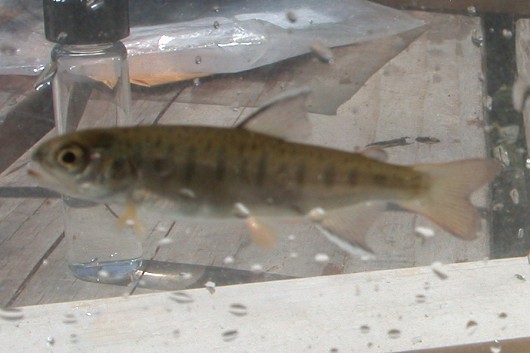 Coho salmon fry taken by Lisa Thompson. Location: Shasta River, California. Date: 4/13/2004. Fish was approximately 6.5 cm long (2.5”).
Coho salmon fry taken by Lisa Thompson. Location: Shasta River, California. Date: 4/13/2004. Fish was approximately 6.5 cm long (2.5”).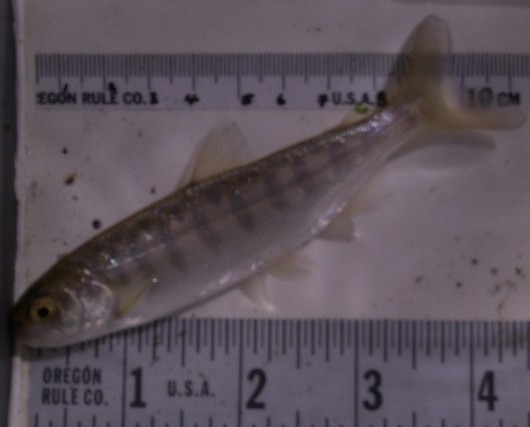 Coho salmon parr taken by Lisa Thompson. Location: Scott River, California. Date: 11/2/2004. Fish was approximately 12 cm long (5”).
Coho salmon parr taken by Lisa Thompson. Location: Scott River, California. Date: 11/2/2004. Fish was approximately 12 cm long (5”).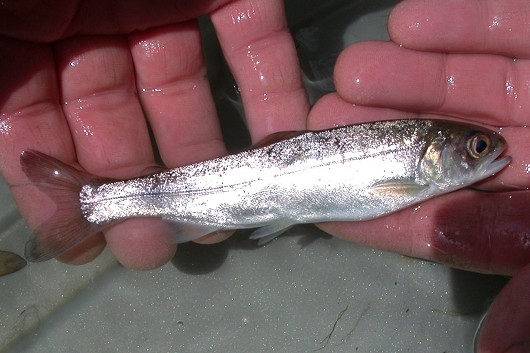 Coho salmon smolt taken by Lisa Thompson. Location: Shasta River, California. Date: 4/15/2004. Fish was approximately 15 cm long (6”).
Coho salmon smolt taken by Lisa Thompson. Location: Shasta River, California. Date: 4/15/2004. Fish was approximately 15 cm long (6”).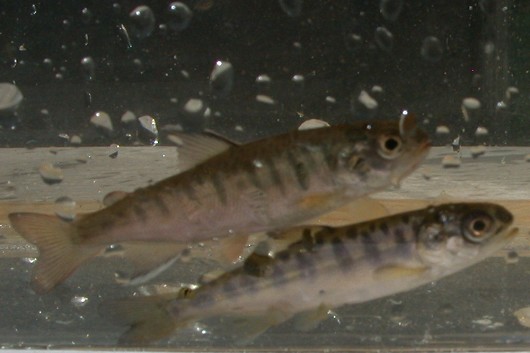 Coho salmon fry (top) and a Chinook salmon fry (bottom). Location: Shasta River, California. Date: 4/13/2004. Fish were approximately 6.5 cm long (2.5”). Photo by Lisa Thompson, UC Davis.
Coho salmon fry (top) and a Chinook salmon fry (bottom). Location: Shasta River, California. Date: 4/13/2004. Fish were approximately 6.5 cm long (2.5”). Photo by Lisa Thompson, UC Davis.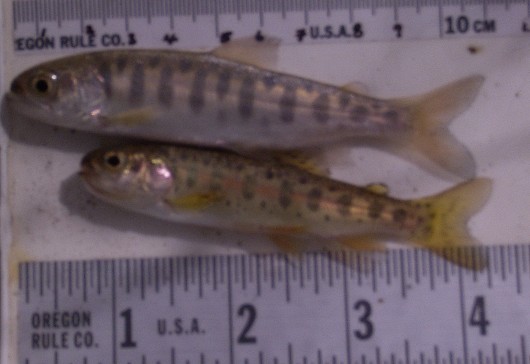 Coho salmon parr (top) and a rainbow trout parr (bottom) taken by Lisa Thompson. Location: Scott River, California. Date: 11/2/2004.
Coho salmon parr (top) and a rainbow trout parr (bottom) taken by Lisa Thompson. Location: Scott River, California. Date: 11/2/2004.PLEASE NOTE: The photos and information shown here are for the species Coho Salmon. Central Coast Coho Salmon are an Evolutionarily Significant Unit (ESU) of Coho Salmon.
- Large adult fish, 55-70 cm FL, 3-6 kg, 10 kg max in CA
- Spawners: black spots on the back, dorsal fin, and upper lobe of caudal fin
- Gums of lower jaw white or gray
- Spawning males: dark red sides, dark green head and back, gray to black belly, strong hooked jaws and humped back
- Spawning females: duller than males, dark pink on the sides, slight hook in jaw
- Juveniles:
- 8-12 narrow parr marks widely spaced along lateral line
- Sickle shaped anal fin, leading edge longer than base, adipose fin “window-like”: dark rim, opaque center
- Caudal, anal, and adipose fins are pale orange
- Fin Rays: dorsal 9-12, anal 12-17, pectoral 13-16, pelvic 9-11
- Lateral line scales: 121-148 with single pore per scale
-
Life History
Coho Salmon, commonly referred to as Silver Salmon, have the southernmost distribution of the salmon species in California. Coho Salmon occupy a sizeable number of streams and survive in conditions considered unfavorable or lethal to most salmon. Coho Salmon hatch from eggs in the spring after months of incubation in cold gravel pockets. Now called alevin, they stay deep within the gravel to avoid predation and emerge days later as fry. Optimal growth occurs at 12-14°C and Coho Salmon fail to survive in streams where the temperature exceeds 22-25°C for extended periods of time. Juvenile Coho Salmon prefer pools and usually begin to favor higher stream velocities as they get older, occupying the midstream and stream margin areas. In situations where dissolved oxygen becomes limited young Coho Salmon may move to riffles and areas of turbulent water earlier in life. The majority of young Coho Salmon remain in their native rearing grounds, though some fish move upstream or downstream to develop in more favorable conditions. Sometimes juvenile Coho Salmon reside in lakes in the shallow zones near shore. Coho Salmon may spend one to several years in their home stream before emigrating down to the ocean. The juvenile Coho transform into smolts as they head for the Pacific Ocean in March, April or May, traveling mostly at night. Upon first arrival in the ocean the fish may stay close to the mouth of their native stream and the continental shelf, dispersing with time. Coho Salmon spend an average of 18 months in the Pacific Ocean growing rapidly, though some males called “jacks” return to spawn early after only 6 months at sea. Coho Salmon sometimes migrate large distances to ideal feeding grounds. The coast of California is often a premier location. Coho Salmon return to their native California streams in November and December as stream flows rise and allow passage upstream to the home spawning grounds. The female usually chooses a swiftwater spot at the top of a riffle to dig several small nests or redds. North American female Coho Salmon produce approximately 1,500-7,000 eggs each, with California stocks typically having relatively low fecundity. Moving upstream the female will deposit her eggs into the nests as a male Coho follows to fertilize. The fertilized eggs are covered and left to incubate during the cool winter months. Both the male and female Coho Salmon then die, though females may guard the nest for up to 14 days before perishing.
-
Links to Other ResearchN / A




